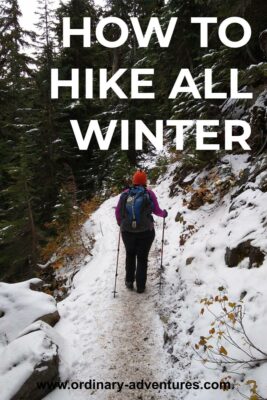How to Hike all Winter in Washington State
Last Updated on April 28, 2025
You likely know, dear reader, that I believe it getting outside as much as possible! Ordinary Adventures is all about keeping it low key so that you can get out more! Previously I’ve talked about how to start hiking as well as how to hike more often. One way to hike more often is to hike all year. Winter brings special benefits including peaceful landscapes, uncrowded trails and boosting your mood on dark days. In this post I’ll outline steps to hike all winter and meet the longer and sunnier days in spring already in the habit of getting outside! If you’re like to take a step beyond hiking and start snowshoeing, learn all about how to do that here.
Hike all Winter with the Right Gear
This is probably the most important thing to keep you safe and comfortable when you hike all winter! You don’t need to spend a fortune and get a bunch of technical gear. You just need to be able to stay warm and dry! If you’re in the Pacific Northwest, check out these suggestions for what I wear in the winter for hiking and other outdoor activities. You can also see this list of everything I bring and everything I wear on a day hike in both winter and summer!
If you’re in a wet climate, you’ll need a rain jacket and waterproof footwear (you might have that already) and some layers so you can be comfortable at a variety of temperatures. You don’t need to have hiking boots, if you have rain boots that works great as long as they’re comfortable! Whatever rain jacket you already have (as long as it’s waterproof) works. You don’t need a special one for hiking.
If you’re in a colder, drier climate, the important thing is to stay warm but not get too sweaty. Again, you probably own what you need! Snow boots are great as long as they’re comfortable. I usually carry one warm layer that I don’t need while moving, so I have something to put on when I take breaks.
Make a list of Winter Hikes
It helps to have a list of hikes you’d like to do that you can only do in the winter, or that are more fun in the winter. When I spent my first winter in Alaska, someone gave me the best advice, which was to find something to look forward to about winter. I held on to this advice when I moved back to Seattle, and I keep a list of snowshoe hikes that I want to do, as well as a list of hikes that are better in winter. For example, Rattlesnake Ledge is a really popular hike near Seattle. It’s a great hike, but it’s very crowded and parking sucks in the spring and summer. I’ve started hiking it only in the winter and it’s perfect. If you need inspiration, check out my list of the best winter hikes near Seattle!
Hike all Winter by being Flexible about destinations
This is really important from a safety perspective, but also to make sure you’re having fun! It’s always important to be flexible about your goals and destinations when hiking, but in winter during shorter days and generally colder temperatures and wetter days it’s even more important. Check forecasts as well as your local avalanche forecast (such as this one for Washington) and look at trail reports to see what current conditions are like. Here are a few examples of ways to be flexible
- High avalanche danger? Try a lowland river, beach or forest hike instead
- Heavy wind? Watch out for areas with heavy forests, where trees may come down. This is particularly problematic if it’s recently been very wet. Try a beach walk instead
- Starting later in the day when you planned? Early Sunset? Plan a hike close to town to maximize the daylight
Get Lighted
When you hike all winter it’s even more important to carry a headlamp with extra batteries in case you get caught out after dark. If you’re hiking in urban environments, reflective gear like a vest or wristbands can also be helpful to stay visible in areas with traffic.
Learn a New Skill
In addition to hiking all winter, there are other closely related activities that are fun to learn such as snowshoeing or cross country skiing. There’s no need to embrace the snow to hike all winter, but if you want to, it’s fun to learn something new! This also helps with having something about winter to look forward to.
Make a New Friend
It’s true that it’s harder to find hiking partners if you hike all winter! If you have a regular hiking buddy, see if you can convince them to expand their season. If not, find new people to go with! You can find them through local hiking groups, meet ups and facebook groups.
I want to see your winter hiking photos! Share them on Instagram and tag @ordinaryadventurespnw










